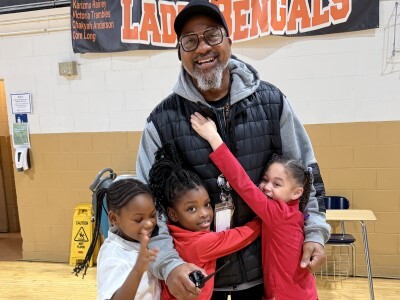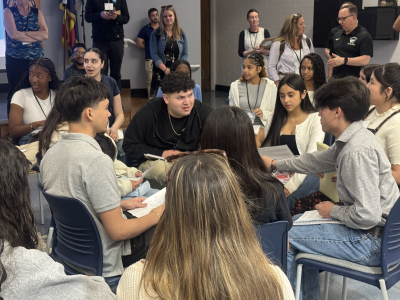K-12 Roundup of Tools and Resources: Distributed Leadership
Topics

Educators are the lead learners in schools. If they are to enable powerful, authentic, deep learning among their students, they need to live that kind of learning and professional culture themselves. When everyone is part of that experiential through-line, that’s when next generation learning thrives.
Practitioner's Guide to Next Gen Learning
Every day, teachers do the hard work of facilitating and supporting student learning. Teacher leadership has a wide and positive impact on students in schools that deeply value and build systems of shared, distributed leadership.
Scholars argue that when teachers are involved in decision making, they feel a greater sense of ownership which leads to strengthened commitment to organizational goals. Makes perfect sense to me! In my nine years as a classroom teacher, I was most empowered when involved in making decisions for the whole school about ways to improve learning outcomes for students.
That said, I was least empowered when I felt like decisions were made for me or forced upon me. Case in point: in my fourth year of teaching, I was forced to deliver a canned reading program my school had adopted. I spent the next year developing skills as a model implementer—doing everything as prescribed and receiving stellar ratings from the coaches during implementation visits. And yet, my students weren’t engaged and their learning suffered. Toward the end of that first year of implementation, I asked my principal for permission to adjust certain aspects of the program to better meet my students’ needs. He said no.
I did not have a formal leadership role in my school’s structure or decision-making authority, so I had to find a way to advocate and try to change the system. I spent the next year collecting research and testimony from my kindergarten students and local experts (other teachers, early childhood advocates at the local university, parents). I collected student learning data to prove to my principal that the mandated one-size-fits-all whole-group instruction model didn’t work for my students. Eventually, my principal allowed me to develop my own reading program with small groups and individualized instruction based on my students’ readiness and interests. Imagine the impact this inquiry project might have had if a group of us were examining the practices and constructing personalized approaches systems-wide!
That systems-wide approach to shared inquiry and problem solving is exactly what Dr. Nicole Assisi, CEO of Thrive wrote about in her recent blog post, 10 Principles to Move Your School Toward Distributed Leadership.
Every day, teachers do the hard work of facilitating and supporting student learning. Teacher leadership has a wide and positive impact on students in schools that deeply value and build systems of shared, distributed leadership. I believe teachers should share and shape the decisions that affect their students.
This week’s Roundup provides tools and information to help you establish or strengthen your systems of distributed leadership.
Administrators of Thrive and Alliance shared how their systems are intentionally built around distributed leadership. I invite you to join in the collaboration and send distributed leadership materials my way.
Thrive Public Schools
Thrive: A K-8 school in San Diego, California. The blended learning model at Thrive integrates technology throughout a curriculum built upon project-based learning, targeted instruction, and tinkering. Thrive embodies a distributed leadership approach.
In an interview, Shelli Kurth, Dean of Teaching and Learning, and Dr. Nicole Assisi, CEO of Thrive, provided a window into distributed leadership at Thrive. Shelli summed it up by saying, “We are not doing our job as leaders if the wheels fall off when we leave the building.”
What does distributed leadership look like in your school?
Key hallmarks:
- Staff meetings, professional development, and events are co-facilitated and co-developed by staff
- Each teacher has a classroom budget to spend as he or she wishes
- School professional learning starts with one week dedicated to Thrive’s mission and vision so all staff head towards the same outcomes without needing directions for each step
Shelli explains that distributed leadership enables the staff to fully own learning and drive decision-making at Thrive. The adults in the system build their own personalized professional development playlist based on individual passions or areas of identified need. Individuals bring learning back to the whole faculty and organize the school’s learning sessions. This is one of the strongest indicators that teachers own the direction of the school and bring Thrive’s vision to life. Another strong indicator is that teachers are encouraged to own problem solving and bring forward issues to tackle. And the same is true for Thrive’s students. Teachers and students owning their learning and driving decision-making—that’s distributed leadership at Thrive.
What impact has distributed leadership had on your teachers and students?
Key hallmarks:
- Authentic and deep voice, choice, autonomy, buy-in
- Things don’t stop working when the school/classroom leaders leave the building
- All staff can represent the vision of the school in conversations with prospective parents or students
Thrive’s distributed leadership resources:
- Protocol: Strengths, Weaknesses, Opportunities, Threats (SWOT) Analysis - This protocol originated from Albert Humphrey's SWOT concept, which he developed at Stanford University in the 1960s and 1970s using data from Fortune 500 companies. The four dimensions of this strategic planning method enable a group to understand internal and external factors that are favorable or unfavorable.
- Protocols: National School Reform Faculty - These protocols provide structure for asking the right questions, listening, and engaging in dialogue in structured ways. The structure becomes internalized over time.
- Book: Crucial Conversations - Thrive uses the framework of best practices within the book as their way of relating to each other, listening, and responding.
Alliance College-Ready Public Schools
Alliance College-Ready Public Schools: a network of 26 high performing charter middle and high schools in the LA area. The academic model at Alliance Alice M. Baxter College-Ready High School provides students the opportunity to self-pace and work through mastery-based progressions in Common Core-aligned courses, California A-G college prep courses, and early college courses. Blended learning in core content classes combine self-paced progress through adaptive online digital content with small group instruction. In his role as Director of BLAST (or Blended Learning for Alliance School Transformation) Implementation, Jonathan Tiongco has organized a network of teacher leaders—called Master BLASTers—to coach colleagues on best practices in blended learning and co-develop professional learning opportunities.
In an interview, Jonathan provided a window into distributed leadership at Alliance:
“Principals and teachers are asked to do a lot. It’s really tough for any one person to hold all necessary knowledge and expertise. Sharing that experience and knowledge is an asset for the school site. Our BLAST Facilitators, or Master BLASTers, serve as leaders and help facilitate knowledge and experience sharing.”
What does distributed leadership look like in your organization?
- Site-based BLAST Facilitators (called Master BLASTers) include one teacher per school who earns a stipend to serve as a blended teacher leader for one year.
- Jonathan, Director of BLAST Implementation along with each school’s BLAST Coach, and the network of Master BLASTers collaborate to lead meetings and organize and participate in classroom walkthroughs.
- Professional development modules are designed based upon themes and needs identified during the walkthroughs and monthly meetings.
- Master BLASTers will participate in a 3-day orientation starting this summer focused on developing the Master BLASTer skill set of coaching, serving as a model teacher, and providing feedback.
What impact has this had on your teachers and students?
- The best people to coach are those who are on the front lines and, as a result, teachers’ instructional practices are stronger because they are coached by Master BLASTers—teacher leaders who are also on the front lines.
- Confidence has increased when teachers lead inside the school and when they are given opportunities for leadership outside the school by presenting at conferences, etc.
- Connections between teachers and the home office administration are stronger and trust is enhanced. We see ourselves as collaborative partners in meeting the needs of students.
- Student achievement improves because instruction is strengthened.
Alliance’s distributed leadership resources:
- Framework for Effective Teaching - Establishes the key look fors and includes Alliance’s blended learning framework. Please contact Jonathan jtiongco@laalliance.org directly for more information.
- Job Description: Site-Based BLAST Facilitator - The role of Master BLASTer defined.
- Blog: High Tech, High Touch, High Five - Signature blended learning practices informed by classroom practice and feedback, and written by Jonathan Tiongco to promote consistent expectations across Alliance’s many classrooms.
Additional Resources
Here are some additional resources to help you incorporate components of distributed leadership into your school model:
Website: Teaching Ahead: A Roundtable - An interactive project jointly developed by Education Week Teacher and the Center for Teaching Quality. Teaching Ahead is inspired by the vision of teaching and learning set out in Teaching 2030, co-authored by 12 teachers and Barnett Berry. You will find information about teacher leadership including teacher leadership projects and system supports to help you build teacher leadership in your context.
Report: Transforming Teachers’ Roles, a new special report from Education Week Teacher, explores transforming teachers’ roles to drive organizational change, build capacity, improve policymaking, and deepen instructional expertise.
Virtual Community: Looking to learn and lead? Join the CTQ Collaboratory, a virtual community where forward-thinking teachers are connecting, learning, and innovating. Join @teachingquality for a #CTQchat every 3rd Thursday, 8:30-9:30 p.m. ET.
Articles: Developing Teacher Leaders - A collection of articles from Education Week Teacher that explores teacher leadership. Read What It’s Like to Teach in a Teacher-Led School by Carrie Bakken, a program coordinator and teacher at the Avalon School in St. Paul, MN and an ambassador for the Teacher-Powered School Initiative.
Website: The Distributed Leadership Study - A collection of projects through Northwestern University’s School of Education and Social Policy. Access projects and publications, and sign up to receive three curriculum modules that explain distributed leadership and can be used to apply the DL framework in one’s own school.
Website: UCLA CenterX Peer Coaching - A collection of resources offering current practices, protocols, and literature on peer coaching. Peer coaching is a process used in distributed leadership to deepen professional collaboration, reflection, and dialogue with the goal of improving instruction.
We want to hear your thoughts: What protocols and processes do you use to build strong distributed leadership in your school?




